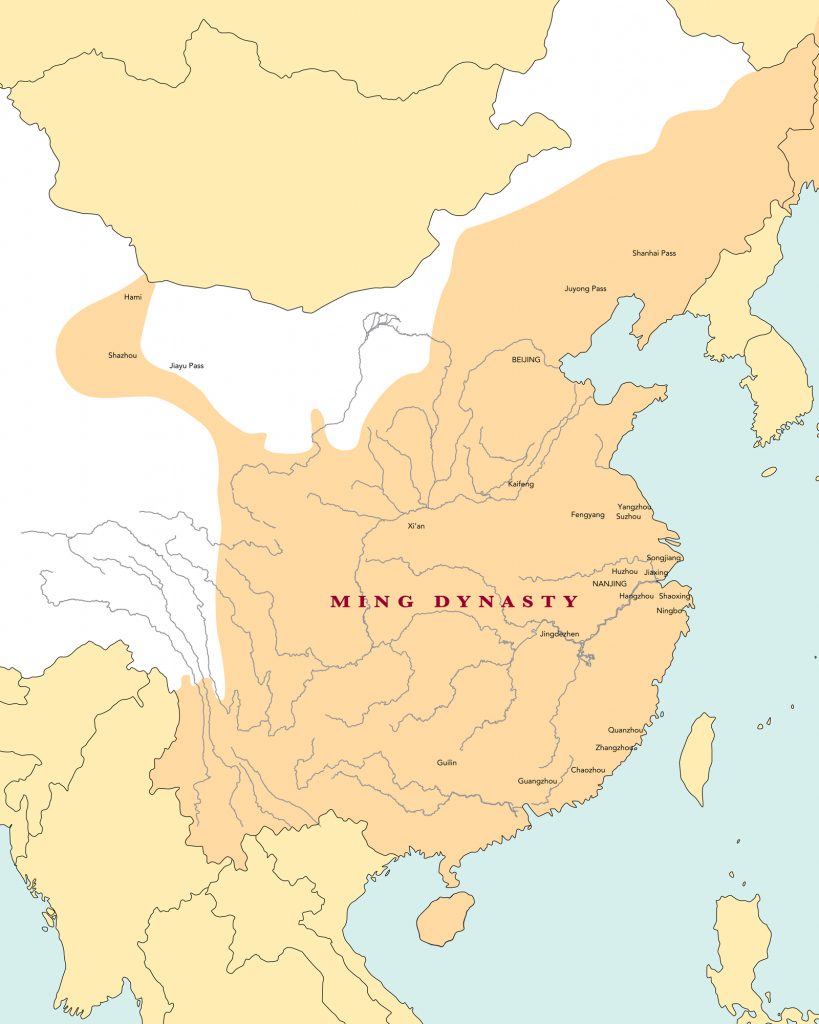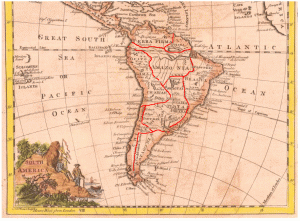The Ming dynasty was founded by Zhu Yuanzhan and spanned nearly 300 years, from the collapse of Yuan Dynasty in 1368 to the dominance of the Manchus in 1644. It encompassed the reign of sixteen emperors and was one of the longest, most stable ruling periods in Chinese history. The dynasty marks a period of Chinese cultural restoration and became known as the “Empire of the Great Ming.” Being the last dynasty to be ruled by true Hans, or ethnic Chinese, it has been called one of the greatest times in human history for government order and social stability. While the dynasty’s reforms made great contributions to the country’s economy and architecture, it struggled with trade operations and its military lacked the ability to protect such a great empire.
The Ming Dynasty was a time in which China experienced economic and population growth. During the Ming period, the Chinese comprised between one-quarter and one-third of the world’s population. The population growth was fueled by several combined factors. First, the Ming government secured extended periods of peace times that aided population growth. Second, China was fortunate not to suffer any nationwide epidemics. Last, China’s geographic layout provided its people with a safeguard against natural disasters, warfare, and social unrest.1

The dynasty established an advanced economy for its time. Trade developed further with the establishment of Beijing and the construction of a canal system. The Grand Canal was renovated between 1411 and 1415, during the Ming Dynasty. The reopening of the canal allowed China to undergo a major commercial revolution, and it served as the economic lifeline for domestic trade within China. Cotton rose as a major commercial crop in China. Produced mainly in the Yangzi River Valley, the Grand Canal was used to keep up with the large demand of both raw and spun cotton. Concurrently, luxury goods such as silk and porcelain were flourishing, and the canal was used to transport these goods to Beijing.2
Industry during the Ming Dynasty also thrived. By 1500, the Chinese were producing large amounts of consumer goods. Chinese goods such as porcelain, lacquerware, and silk found their way to major cities around the world. Well-known Chinese wares, characterized by their cobalt-blue painted motifs, were produced during this era. An abundance of paper was also produced, which led to new methods of printing and gave rise to a substantial publishing industry. The Chinese published everything from fine Chinese classics to common handbooks for travel and daily life, to novels filled with fighting and sex.3
The Chinese government had developed a foreign policy known as the tribute system to help them negotiate with the outside world, and the Ming Dynasty promoted it early on. Under this system, the Chinese treated their neighboring lands as tributary states. The tributary state agreed to take on the status of vassal to the Chinese and were required to exchange gifts, monitor foreign trade, and handle diplomatic relations. The tribute required from the tributary state was not enormous and they could remain independent of China. The tributary states would send goods to China with their diplomatic missions and then they would also receive gifts from the emperor. This helped maintain peaceful bonds and stability among the states and China while increasing trade. The tributary states would benefit from this system because they could obtain the goods they wanted from China without having to go to war. The system also sponsored a series of seven great maritime expeditions, from 1405 to 1433, led by Zheng He. He used these expeditions to invite states to join the tributary trade and prohibit private citizens from participating in maritime trade. After 1433, the Ming government ended these expeditions as they believed they had what they needed domestically. With the end of the expeditions, China turned inward, reduced it contacts with the world beyond its borders, and caused many of their merchants to turn to smuggling to survive.4
The Ming Dynasty’s military system was created during the rule of Emperor Hongwu and lasted until the end of the Ming Dynasty. The army was commanded by a hereditary officer class. Members of the military and their income was to be provided by their families. Each family was to provide for ten soldiers, of which three were assigned to military tasks and seven to farming the land of the military colonies.5
The dynasty attempted to create a strong military by utilizing elements of the Yuan system with others and creating a system called the weisuo system. The system utilized military garrison units to maintain peace. The system consisted of a guard unit of 5600 men known as a wei. Each wei was then divided into five qianhu suo consisting of 1,120 men in each. The qianhu suo was then divided into ten units called baihu suo of 112 men each. Each garrison unit was allotted a tract of military-owned land that they were required to work on to provide their own food. This system was designed to reduce the cost to the public and to make the military more efficient. Military soldiers were usually of low social status and desertion became a serious problem. Additionally, because the military was running under hereditary practices, it was difficult for the government to replace deserters in addition to battlefield casualties. In addition to the problem of desertion, the other major issue with the weisuo system was that many of the garrison units were unable to produce enough food supply in order to feed themselves.6
The Ming Dynasty’s military was also limited by its centralized planning approach. When preparing for certain campaigns, the entire military would be reequipped and retrained for the mission. Doing this caused a number of bureaucratic issues, ultimately making the military slow to respond to threats. Their cavalry was also not heavily equipped when their equipment was replenished. Troops were frequently used for non-military purposes, which significantly reduced the number of battle-ready troops.
The Ming Dynasty was one of the most successful eras in Chinese history. At its peak, it made China a global powerhouse by influencing the world with its social and economic stability. However, their greatness was marred by a weak, poorly trained military that lacked in abilities, equipment, and planning. Their inefficient military and restrictions on maritime trade created huge hardships during this brilliant era in Chinese history.
- Berkshire Encyclopedia of China: Modern and Historic Views of the World’s Newest and Oldest Global Power, 2009, s.v. “Grand Canal,” by Andrew Field. ↵
- John E. Wills, “Empire, Ming” History of World Trade Since 1450, vol. 1 (2006): 234-237. ↵
- Berkshire Encyclopedia of China: Modern and Historic Views of the World’s Newest and Oldest Global Power, 2009, s.v. “Porcelain” by Ooi Giok Ling. ↵
- Guangqiu Xu, “Ming Dynasty (1368-1644): Foreign Trade,” in World Eras, vol. 7 (2003): 204-205. ↵
- Guangqiu Xu, “Ming Military Expansion and Political Reforms,” in World Eras, vol. 7 (2003): 259-261. ↵
- Guangqiu Xu, “The Military Organization,” in World Eras, vol. 7 (2003): 253-255. ↵



21 comments
Joshua Breard
Reading about this Chinese history is incredible as it is rich and interesting to compare it to how we think today. I do find it interesting about how the military struggled with food production given the geographical location of the place. It is little things like this that get often overshadowed in history so I think you did a great job of covering the highlights while also covering some other small topics. Great job!
Christine Sackey
I had heard about the Ming dynasty but I did not know how big it actually was. It is amazing how advanced they were for their time. I especially thought that the tribute system was especially thought creative and innovative. It is sad that the dynasty ended due to not well thought out plans and a weak military. Though it ended it was part of one of the greatest eras.
Robert Rees
What stood out in the this article to me were the negative repercussions China faced by adopting an isolationist policy. I have previously researched Japan and found that they faced very similar consequences when their government closed off their borders. While learning that an island nation’s plan to close their borders backfired wasn’t shocking information to me, I was surprised to learn China dealt with similar problems. I did not expect the learn that the Ming Dynasty’s military faced food production problems, given the abundance of rivers and its access to the sea. Overall this article was very informative and an interesting read.
Alexis Soto
This was a great informative article on the Ming Dynasty. China has one of the most complex and intriguing histories of any nation on Earth. My knowledge of Chinese history if few so I was thrilled when I saw your article. I will always jump at the opportunity to learn about a historical event this was no exception. Great read!
Zaraly Frasquillo
I was always fascinated with the Ming Dynasty and I believe your article gave it justice. I loved that you went into detail on how and why the Ming Dynasty became the most successful. You also had a great time all throughout your article. I had no clue that they had a weak army which incredible to me and super shocking. Great job, I really enjoyed your article!
Hayden Hollinger
This was a good article. This was a topic that I had no prior knowledge of and I thought you did a good job of explaining what the Ming Dynasty was all about. After reading your article I feel like I have a good understanding of the topic so your article was successful in that sense. I thought the images you used could have been better, but overall a decent article.
Irene Astran
I think you could branch off from this article to write an entirely different piece on what strategy China utilized in order to ensure they would not suffer nationwide epidemics. I wonder if other countries have used China, at that specific point in time, as a model on how to safeguard present day nations. I would be extremely interested in reading into this aspect of China’s history.
Faisal Alqarni
Hi Jaramiro, I always knew a bit about the Ming dynasty like the fact that they were an asian monarchyy but your articl has shed more light on this, facts such as that it is the longest running Chinese dynast are new to me. I can say their weak army was one of the ways this dynasty that seemed to know what it was doing chose wrong. Thank you for this enlightening piece.
Bailey Rider
Great article! I learned a lot about the Ming Dynasty from your article that I didn’t know before! It suprised me to learn that they had a weak army even through they were so stable and successful. Your article was well researched and a very interesting read. I also liked the images you put into your article. Thanks for the great article!
Mario De Leon
This was a great article. I have never taken the time to really study Chinas different dynasties but our article has inspired me to look further into them. Even though the Ming dynasty was one of the most successful dynasties I find it strange they would have a stronger military especially since a strong military would help them establish hard power in the world.